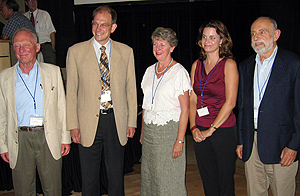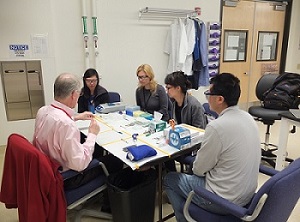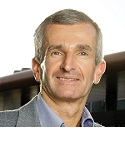Vol. 16, No. 10 - May 2016
View the Archives

Science Highlight
Measuring Real-time Biological and Abiotic Manganese Oxide Reduction – Contact: Contact: Jena Johnson (University of Colorado) The element manganese can have complex interactions with the environment, depending on the prevailing conditions. Manganese(IV) is a strong oxidant but can also bind to environmental toxins and heavy metals, rendering them less harmful. Both geochemical and microbial processes affect the reactions of manganese(IV) in the environment. A team of researchers were interested in following the complicated reactions and mineral products produced during the reduction of manganese(IV) under different environmental conditions. Read more... A Pioneer - Edward A. Stern
It is with great sadness that we are passing along the news that one of our earliest users at SSRL has died. Professor Ed Stern of the University of Washington passed away in May 2016. Along with Farrel Lytle and Dale Sayers, he pioneered the modern age of Extended X-ray Absorption Fine Structure (EXAFS). At was then the fledgling Stanford Synchrotron Radiation Project, the University of Washington group along with Bell Labs built SSRP's first EXAFS beam line that was part of the first suite of beam lines beginning operation in 1974. This synchrotron beam line, coupled with EXAFS theory that Ed, Dale and Farrel had developed just a few years before, enabled EXAFS to go from a very limited technique to one that simply took off and continues to be one of the mainstays of SSRL's current experimental program, with broad impact in areas of science that include chemistry, materials science, biology and environmental science. Ed continued developing and using EXAFS throughout his illustrious career and championed beam lines at both the NSLS and the APS. We all have fond memories of Ed and will remember his long-lasting contributions to the laboratory. For a history of the development of extended x-ray absorption fine structure as recounted by Farrel Lytle, see: F. Lytle, "The EXAFS Family Tree: a Personal History of the Development of Extended X-ray Absorption Fine Structure", J. Synchrotron Rad. 6, 123 (1999). Workshop SummariesCrystallization Workshop: Focus on Micro and Nano Crystals and High Throughput Methods 2016 The workshop took place at SSRL April 19-22. Hosted by the Structural Molecular Biology (SMB) program in tandem with RapiData 2016 this was the first time that this course was offered on the West Coast. Previously hosted by the National Synchrotron Light Source (NSLS) at Brookhaven National Laboratory (BNL), the purpose of this course series is to provide participants with hands-on experience of a variety of macromolecular crystal growth methods.
This year the course focused on micro and nano crystals and high throughput methods for synchrotrons and XFELs. Forty-three participants and 20 lecturers and tutors from the US and abroad discussed, and experienced hands-on, the complexity of the crystallization process. Nine lectures introducing basic concepts ranging from standard manual and automated crystallization methods to high density crystallization formats and injectors for XFELs preceded the practical and tutorial demonstration sessions. Nine different crystallization robotic systems were utilized and presented to the participants who could probe them during the tutorials to set their own crystallization trials. Twenty-three participants brought their own proteins and took advantage of the different methods being taught during the hands-on sessions. Crystals obtained were tested during the RapiData 2016 course that immediately followed this workshop. Several participants took home new crystallization conditions and even a few diffraction data sets. Participant comments included “cutting-edge, informative, problem-solving, networking”. In addition to NIH-NIGMS and DOE-BER funding, this course would not have been possible without the generous participation of the many companies that supply and support research in academic, government and biotech institutions. RapiData 2016 The RapiData 2016 course in data collection and structure solving for macromolecular x-ray crystallography was held at SSRL from April 24-29. The aim of this course series is to educate and train young scientists in data collection and data processing methods at synchrotron beam lines, using state-of-the-art software and instrumentation. The workshop was hosted for the second time by the SSRL's SMB group after having been held at the NSLS for the previous 16 years. The 2016 course attracted 43 participants from around the world. The dates were chosen so that the course followed the Crystallization course that took place the preceding week. Many participants attended both events. The workshop started on Sunday, April 24 with a five-hour lecture by Bob Sweet (BNL) on the fundamentals of crystallography to ensure that students without much previous experience in crystallography could benefit fully from the lectures and practicals during the rest of the course. The agenda on Monday and Tuesday included lectures covering topics ranging from light sources, sample preparation and data collection indexing to integration and phasing. Hands-on tutorials on sample preparation, data reduction and structure solving software started on Tuesday evening, and ran in parallel with data collection at five SSRL beam lines. Students were encouraged to bring their own specimens for data collection, and previously measured data for processing and structure solution. As mentioned above, the participants who were able to grow crystals during the protein crystallization workshop also got the opportunity to collect data from these crystals during the RapiData course. Participants expressed a high degree of satisfaction with the course and we look forward to hosting the course again at SSRL in the spring of 2017. Remote Access Data Collection Workshop in Puerto Rico: Automation and Robotics at the SSRL Macromolecular Crystallography Beam Lines A workshop describing and demonstrating the state-of-the-art facilities at SSRL that are available to the general user community for structural biology research took place at the University of Puerto Rico-Mayaquez on May 6-7. SSRL staff traveled to Puerto Rico at the invitation of Professor Juan Lopez-Garriga to facilitate the workshop. For several years Professor Lopez-Garriga has run a successful crystallization competition in local Puerto Rican high schools, where the students have been exposed to the techniques necessary to grow protein crystals. However, there is currently no capability on the island to measure diffraction data from the crystals that the students have grown, and the determination of the structures of the proteins. This workshop was aimed primarily at high school teachers from various schools around the island who participate in the crystallization competition, with the goal of the workshop to train the teachers in the remote access tools available at SSRL. The ultimate aim of the project is to take crystals that the high school students will grow in this year’s competition and send them to SSRL for data collection, data processing and structure determination. To this end, it was important that the teachers involved in the crystallization competition understand the practical aspects of crystal preparation, shipping to SSRL and the remote access experiment so that they can guide their students during this process, topics that were all covered. AwardAxel Brunger Receives ACA Trueblood Award
Axel Brunger, Professor of Molecular and Cellular Physiology, Neurology and Neurological Sciences, Structural Biology (by Courtesy), and Photon Science at Stanford, HHMI Investigator, and a key member of the SSRL Structural Molecular Biology program, has been awarded the 2016 American Crystallographic Association Trueblood Award. The award notice quotes how Brunger’s “contribution to computational crystallography has been invaluable for the development of modern macromolecular crystallography,” and how he ”carries out cutting-edge research on the molecular mechanisms of synaptic neurotransmitter release, complementing x-ray crystallography with electron microscopy and single molecule microscopy and exploring the new possibilities that x-ray free electron laser techniques offer for the structural determination of large macromolecular assemblies.” The award will be presented at the July ACA meeting. Introducing New SSRL StaffSimon Bare joins SSRL Chemistry and Catalysis Division Simon Bare, former Research Fellow at UOP LLC, recently joined SSRL as Distinguished Staff Scientist. He is a leading scientist in development of x-ray methods and instrumentation for catalyst characterization, has a very significant background in heterogeneous catalysis research, and will lead developments of SSRL’s chemistry and catalysis program. Kelley Anderton, SSRL Proposal Administrator Kelley Anderton has joined the SSRL User Services Office as Proposal Administrator. Contact Kelley for information or assistance regarding SSRL Materials Sciences, Chemistry and Catalysis (X-ray/VUV) proposals, reviews, or beam time preparations. Kelley brings extensive administrative experience in a variety of fields including biotechnology and finance. Please stop by Building 120, Room 211 to say hello to Kelley! Upcoming Events12th International Conference on Biology and Synchrotron Radiation -
August 21-24, 2016 This meeting provides a forum for scientists involved in research and development on synchrotron and free electron laser sources to come together with a broad community of biologists, with the ambition to make the best use of the most advanced infrastructures in structural biology. Possible applications range from atomic-resolution and time-resolved structures of biological macromolecules, medium resolution images of the largest molecular complexes in the living word, and cellular and sub-cellular structures. Scientists at all possible career levels are invited to this meeting – ranging from graduate students, postdoctoral fellows, and principal investigators both from academia and industry. There will be ample opportunities for individual presentations. Conference website Save the date for the 2016 SSRL/LCLS Annual Users' Conference and Workshops, October 5-8 Plan to attend the Annual SSRL/LCLS Users' Conference and Workshops to be held at SLAC October 5-8, 2016. Contact the organizing committee to share your input on potential invited speakers. The list of tentative workshop topics follows:
Users' Conference and Workshops website AnnouncementsCall for SSRL Annual Award Nominations August 1: William E. and Diane M. Spicer Young Investigator Award All SSRL users and staff are eligible for this $1,000 award honoring the professional and personal contributions that William E. and Diane M. Spicer made to our community. Submit nominations for the Spicer Young Investigator Award by August 1, including a letter of nomination summarizing the technical or scientific contributions of the candidate, the candidate's curriculum vitae and publications. Supporting letters are also encouraged. August 15: Melvin P. Klein Scientific Development Award The $1,000 award honoring Melvin P. Klein's many contributions is intended to recognize outstanding research accomplishments by new investigators and to promote dissemination of research results based on work performed at SSRL. Nominations for undergraduate or graduate students, or postdoctoral fellows within three years of receiving their Ph.D., should be submitted by the August 15 deadline. The nomination package should include a letter of recommendation from the advisor as well as an abstract written by the candidate describing the SSRL-related experiments and scientific results. Candidates are encouraged to include their curriculum vitae and information on their plans to present their work at a scientific conference. August 15: Farrel W. Lytle Award The Farrel W. Lytle Award was established to promote important technical or scientific accomplishments in synchrotron radiation-based science and to foster collaboration and efficient use of beam time among users and staff at SSRL. SSRL users and staff are eligible to be nominated for the $1,000 Lytle Award, but only nominations for individuals will be considered (no group awards please). Submit nomination letters by August 15 including a summary of the individual's contributions and why they should be recognized through this award. Supporting letters are also encouraged. Nomination packages for all three awards should be sent by email to the attention of Cathy Knotts. knotts@slac.stanford.edu. These awards will be presented during the Users' Conference Plenary Session on October 6. The awardees of the Spicer and Klein awards will be asked to give a presentation on his/her research during the Users' Conference. User Research AdministrationProposal Deadlines July 1, 2016 - SSRL Macromolecular Crystallography proposals (for beam time eligibility beginning fall 2016) September 1, 2016 - SSRL X-ray/VUV Proposals (for beam time eligibility beginning in late winter 2017) Submit proposals and beam time requests through the user portal. The Stanford Synchrotron Radiation Lightsource (SSRL) is a third-generation light source producing extremely bright x-rays for basic and applied research. SSRL attracts and supports scientists from around the world who use its state-of-the-art capabilities to make discoveries that benefit society. SSRL, a U.S. DOE Office of Science national user facility, is a Directorate of SLAC National Accelerator Laboratory, operated by Stanford University for the U.S. Department of Energy Office of Science. The SSRL Structural Molecular Biology Program is supported by the DOE Office of Biological and Environmental Research, and by the National Institutes of Health, National Institute of General Medical Sciences. For more information about SSRL science, operations and schedules, visit http://www-ssrl.slac.stanford.edu. To unsubscribe from SSRL Headlines, just send an e-mail to listserv@slac.stanford.edu with "signoff ssrl-headlines" in the body. To subscribe, send an e-mail to listserv@slac.stanford.edu with "subscribe ssrl-headlines" in the body. Questions? Comments? Contact Lisa Dunn
|




